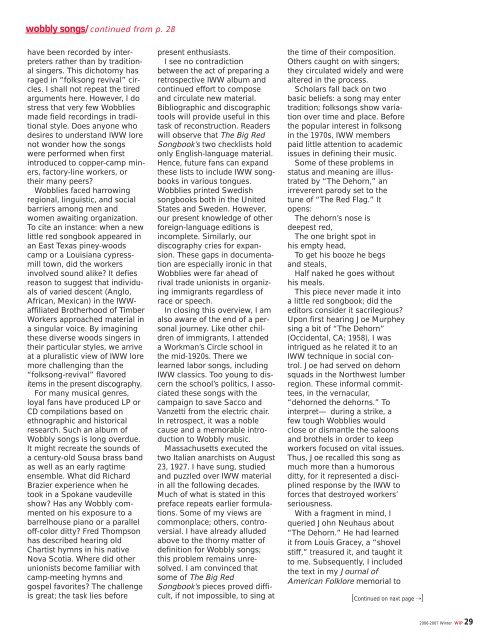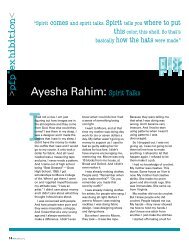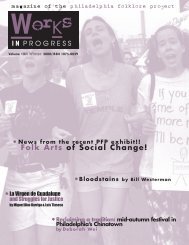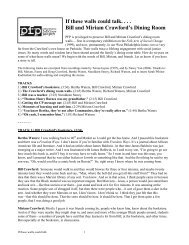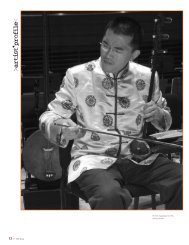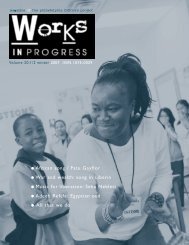View PDF - Philadelphia Folklore Project
View PDF - Philadelphia Folklore Project
View PDF - Philadelphia Folklore Project
- No tags were found...
You also want an ePaper? Increase the reach of your titles
YUMPU automatically turns print PDFs into web optimized ePapers that Google loves.
wobbly songs/continued from p. 28have been recorded by interpretersrather than by traditionalsingers. This dichotomy hasraged in “folksong revival” circles.I shall not repeat the tiredarguments here. However, I dostress that very few Wobbliesmade field recordings in traditionalstyle. Does anyone whodesires to understand IWW lorenot wonder how the songswere performed when firstintroduced to copper-camp miners,factory-line workers, ortheir many peers?Wobblies faced harrowingregional, linguistic, and socialbarriers among men andwomen awaiting organization.To cite an instance: when a newlittle red songbook appeared inan East Texas piney-woodscamp or a Louisiana cypressmilltown, did the workersinvolved sound alike? It defiesreason to suggest that individualsof varied descent (Anglo,African, Mexican) in the IWWaffiliatedBrotherhood of TimberWorkers approached material ina singular voice. By imaginingthese diverse woods singers intheir particular styles, we arriveat a pluralistic view of IWW loremore challenging than the“folksong-revival” flavoreditems in the present discography.For many musical genres,loyal fans have produced LP orCD compilations based onethnographic and historicalresearch. Such an album ofWobbly songs is long overdue.It might recreate the sounds ofa century-old Sousa brass bandas well as an early ragtimeensemble. What did RichardBrazier experience when hetook in a Spokane vaudevilleshow? Has any Wobbly commentedon his exposure to abarrelhouse piano or a paralleloff-color ditty? Fred Thompsonhas described hearing oldChartist hymns in his nativeNova Scotia. Where did otherunionists become familiar withcamp-meeting hymns andgospel favorites? The challengeis great; the task lies beforepresent enthusiasts.I see no contradictionbetween the act of preparing aretrospective IWW album andcontinued effort to composeand circulate new material.Bibliographic and discographictools will provide useful in thistask of reconstruction. Readerswill observe that The Big RedSongbook’s two checklists holdonly English-language material.Hence, future fans can expandthese lists to include IWW songbooksin various tongues.Wobblies printed Swedishsongbooks both in the UnitedStates and Sweden. However,our present knowledge of otherforeign-language editions isincomplete. Similarly, ourdiscography cries for expansion.These gaps in documentationare especially ironic in thatWobblies were far ahead ofrival trade unionists in organizingimmigrants regardless ofrace or speech.In closing this overview, I amalso aware of the end of a personaljourney. Like other childrenof immigrants, I attendeda Workman’s Circle school inthe mid-1920s. There welearned labor songs, includingIWW classics. Too young to discernthe school’s politics, I associatedthese songs with thecampaign to save Sacco andVanzetti from the electric chair.In retrospect, it was a noblecause and a memorable introductionto Wobbly music.Massachusetts executed thetwo Italian anarchists on August23, 1927. I have sung, studiedand puzzled over IWW materialin all the following decades.Much of what is stated in thispreface repeats earlier formulations.Some of my views arecommonplace; others, controversial.I have already alludedabove to the thorny matter ofdefinition for Wobbly songs;this problem remains unresolved.I am convinced thatsome of The Big RedSongbook’s pieces proved difficult,if not impossible, to sing atthe time of their composition.Others caught on with singers;they circulated widely and werealtered in the process.Scholars fall back on twobasic beliefs: a song may entertradition; folksongs show variationover time and place. Beforethe popular interest in folksongin the 1970s, IWW memberspaid little attention to academicissues in defining their music.Some of these problems instatus and meaning are illustratedby “The Dehorn,” anirreverent parody set to thetune of “The Red Flag.” Itopens:The dehorn’s nose isdeepest red,The one bright spot inhis empty head,To get his booze he begsand steals,Half naked he goes withouthis meals.This piece never made it intoa little red songbook; did theeditors consider it sacrilegious?Upon first hearing Joe Murpheysing a bit of “The Dehorn”(Occidental, CA; 1958), I wasintrigued as he related it to anIWW technique in social control.Joe had served on dehornsquads in the Northwest lumberregion. These informal committees,in the vernacular,“dehorned the dehorns.” Tointerpret— during a strike, afew tough Wobblies wouldclose or dismantle the saloonsand brothels in order to keepworkers focused on vital issues.Thus, Joe recalled this song asmuch more than a humorousditty, for it represented a disciplinedresponse by the IWW toforces that destroyed workers’seriousness.With a fragment in mind, Iqueried John Neuhaus about“The Dehorn.” He had learnedit from Louis Gracey, a “shovelstiff,” treasured it, and taught itto me. Subsequently, I includedthe text in my Journal ofAmerican <strong>Folklore</strong> memorial to[Continued on naxt page ➝]2006-2007 Winter WIP 29


